What Conclusions Can You Draw From The Spot Plate Tests?
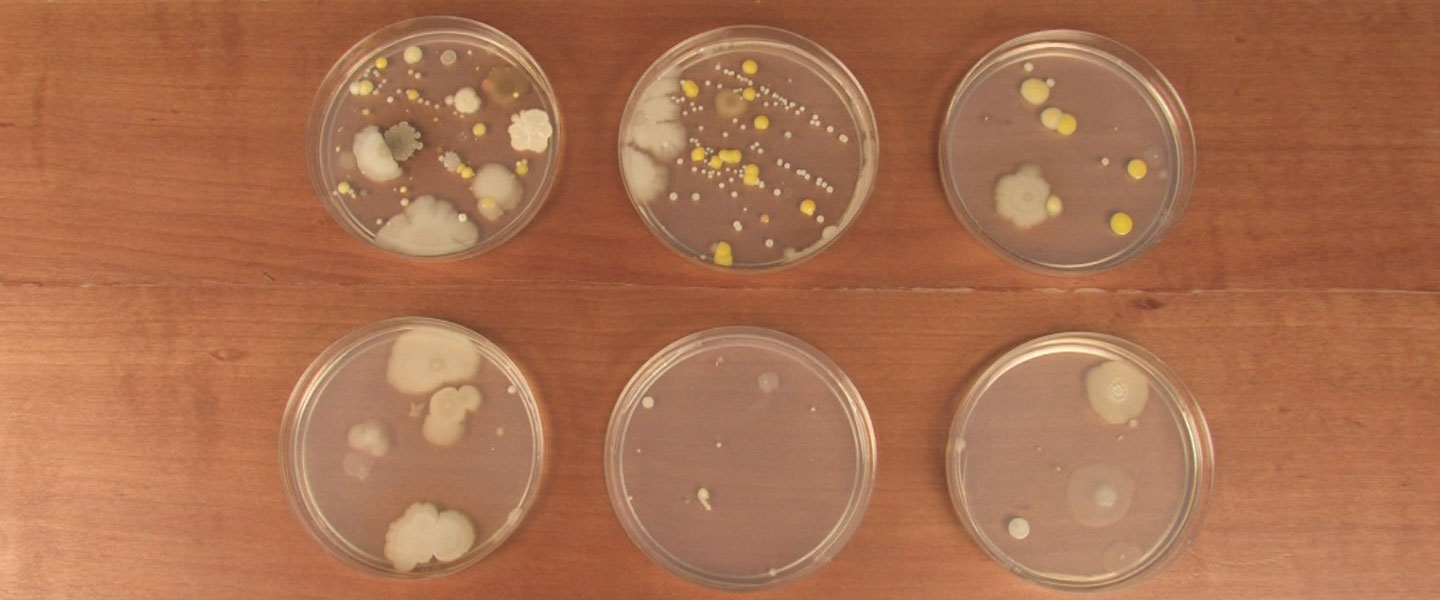
Growing Bacteria in Petri Dishes Experiment
Take samples around yous and run across what bacteria volition grow in an agar-filled Petri dish.
Growing Bacteria in Petri Dishes Experiment
Looking for the best hands-on bacteria science off-white projects that will really wow friends and family? Steve Spangler Science has a great selection of culturing bacteria ideas, easily-on experiments and leaner science fair projects for kids! Our super-fun projects and culturing leaner experiments will help your immature scientists experience amazing and memorable bacteria growth before their optics — in petri dish in your dwelling house or classroom!
Culturing Bacteria in a Petri Dish with Agar
Collect samples around you, test them and run across what bacteria will grow in an agar-filled petri dish. These samples can be from anywhere: test toilet seats, doorknobs, refrigerator doors, faucet taps and other surfaces in your home or school to see what yucky fomites are lurking in the realms of the elusive and seemingly invisible cellular level.
Science Experiments at Steve Spangler Science
You simply never know what goobers are festering in the recesses of microbiology. It may be shocking when you quickly see a petri dish filled with leaner emerge. With this experiment, you will likely realize that your mom was right when she told yous to "Wash your hands with lather and warm water!" This easy-to-use scientific discipline experiment uses a petri dish prepared with food agar (a seaweed derivative with beef nutrients added) and is an ideal way to reveal the bacteria hiding all effectually you. Y'all may not believe what yous detect hiding in all corners of your home or schoolhouse!
Leaner Experiments and Products
Follow the footstep-by-step instructions beneath for a learning experiment that kids of all ages will remember. For an all-in-one kit, be sure to cheque out our Growing Bacteria science kit. Demand additional petri dishes to supply your yearning for learning about bacteria in your surround? Order more petri dishes from our comprehensive selection of lab supplies at Steve Spangler Science!
Growing Bacteria Kit
Experiment Videos
Experiment
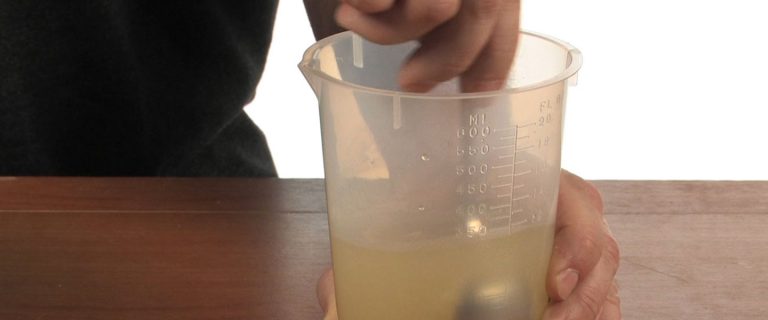
1
Y'all'll need a clean, microwave-safe container (a quart-sized bowl works great) to mix the agar with water and then eddy it. These proportions brand plenty nutrient agar to prepare two Petri dishes. Stir these together well:
• ½-teaspoon agar (about 1.2 grams)
• ¼ cup (threescore mL) of hot h2o
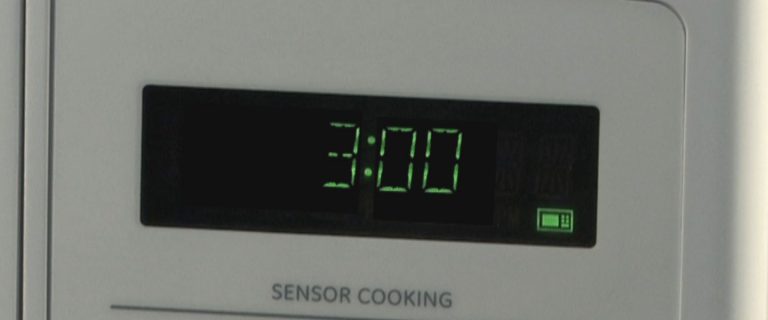
2
Bring this mixture to a boil for three minutes to completely dissolve the agar. CAUTION: Adult supervision is required to boil water. If you are using a microwave oven to eddy the mixture, be careful not to let it boil over. The mixture should be clear with no particles floating in it afterward humid.

iii
Remove the mixture from the microwave and permit information technology to cool for three to 5 minutes earlier moving on to the next step.
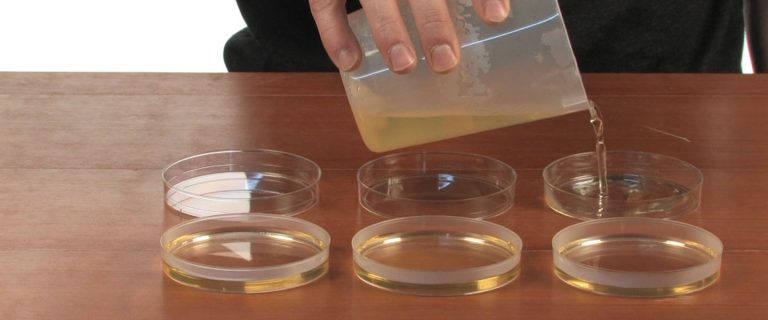
4
Have the lid off of the Petri dish (the chapeau is larger than the dish) and carefully cover the bottom-half of the Petri dish with warm nutrient agar mixture.
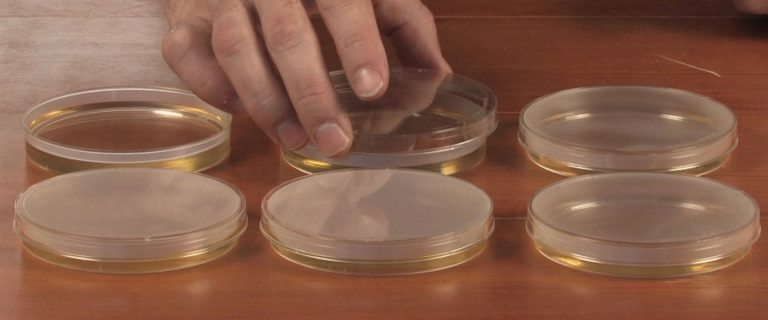
five
Loosely cover the bottom portion (prepare the lid ajar so backlog wet can escape) and permit the mixture to cool and harden for at least an 60 minutes.
NOTE: Merely like gelatin, agar needs to boil for a certain amount of time to properly gel. If necessary, pour any unset mixture in each Petri dish dorsum into the bowl (Cover the empty dishes!) and microwave information technology again until you run across it boil. Watch information technology eddy (but not eddy over) for ten-15 seconds earlier turning off the microwave. In that location should be no "floaties" in it. Cascade the hot agar mixture dorsum into the dishes (encompass them!) as you did before and it should solidify within an 60 minutes.
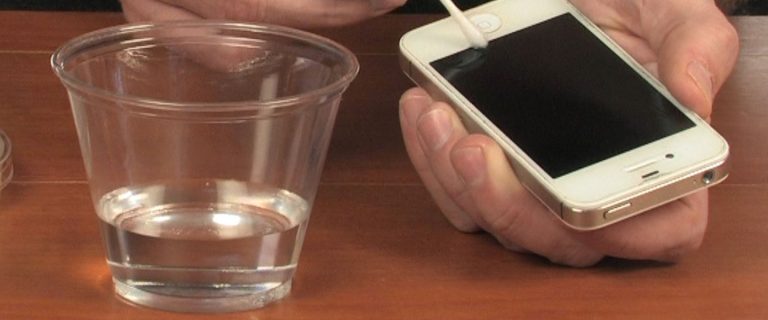
half-dozen
It's time to collect some bacteria on the terminate of a cotton swab! The classic test is to roll a clean cotton swab in your oral fissure and then to lightly draw a squiggle with it on the gelled agar. However, many people like to test something even more gross like the keys on a reckoner, a cell phone case, the pump handle of a soap dispenser, or the TV remote command. Unless someone recently cleaned the buttons on the remote, you may be seeing some real goobers in a short fourth dimension. Dampen a cotton swab and roll information technology in your fingers as you pull it across the surface of your choice.
NOTE: You might want to collect a sample from a computer keyboard on one-half of the Petri dish and leave the other half for the exam in Steps 8/9. Remember, you MUST use clean cotton swabs for EACH sample. In gild to get a good sample, lightly dampen the cotton wool swab with water. Be sure to roll the swab in your fingers so all of it touches all of the surface to be tested. You want to cover the unabridged cotton wool end of the swab with invisible bacteria. Other things that yous might test include: door handles, your hands, under your fingernails, the meridian of a desk, a pencil or a pen, the expanse around a bathroom sink, a figurer, or a favorite toy.
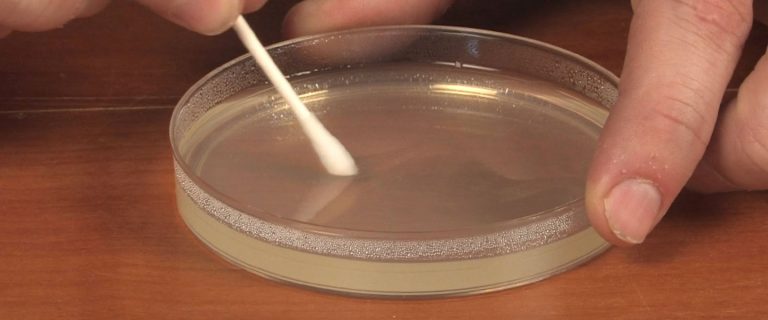
seven
Lift the lid off the Petri dish and LIGHTLY draw a squiggly line in the agar with the end of the cotton swab. Curl the swab in your fingers as you draw the line. Supercede the hat and label the dish with the appointment and the name of the item you tested.
NOTE: Moisture coming from the agar can be a trouble. Many people turn the Petri dish over during this time to prevent moisture from dripping onto the growing colonies. A suggestion: Identify a driblet (no more) of a hand sanitizing gel in the eye of one of the squiggles. The hypothesis is that the antibacterial chemical in hand sanitizer will go along bacteria from growing in that location.
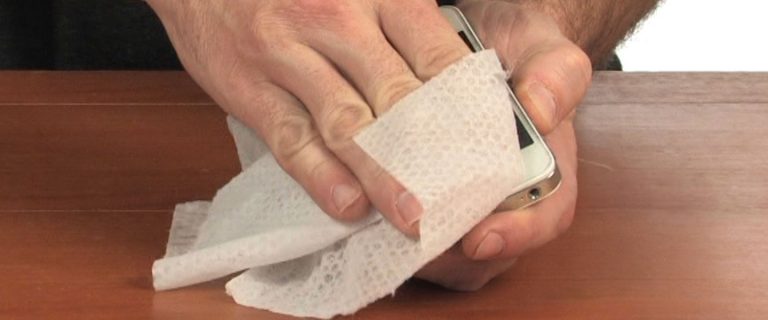
8
Use a sanitizing wipe to thoroughly make clean one of the surfaces you tested in Step 6, due east.chiliad. Cellphone
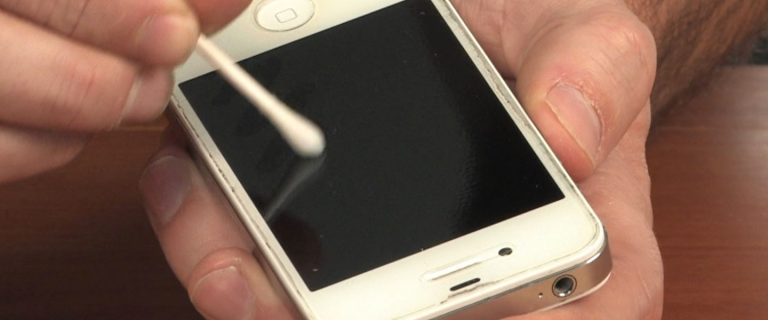
9
With a clean swab, redo the squiggle examination in the other half of the Petri dish from Pace 6 to ostend your cleaning efforts.
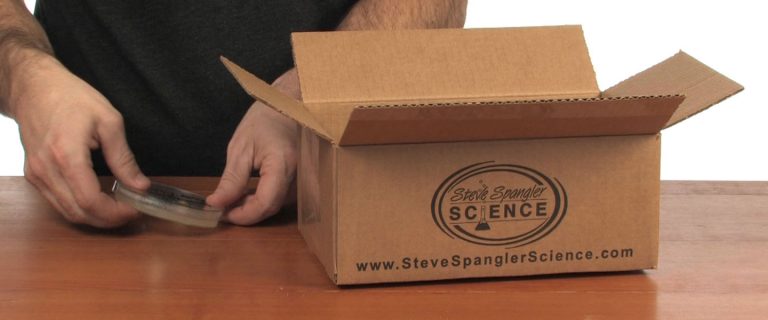
10
Before growing annihilation, some people place each Petri dish into a dissever zipper-lock bag. Place the upside down dishes into a warm – about 98°F (37°C) is fine – and totally dark identify to grow. In a closed box on a cable box is a great identify. In a short fourth dimension, you'll be greeted by an amazing variety of bacteria, molds, and fungi. Yous likely see more and larger colonies over the next few days. You shouldn't see too much growth where the disinfectants (hand sanitizers) were used. You might even encounter a "halo" effectually each location. This halo is called the "kill zone." Measure out and compare the size of the impale zone to determine the effectiveness of different antibacterial agents.
Call back: Practise NOT open the dishes once things begin to grow. Yous could be culturing some serious goobers and not even know information technology. The comfort is that they were around you all the time anyway and now you tin can see them. Simply exist conscientious!
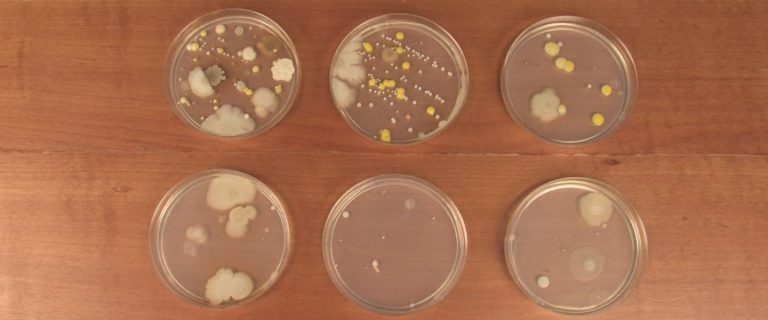
xi
Goobers like you lot're growing volition often stink and brand their presence known after a short time. These are non toys or curiosities you're growing. Proper disposal is essential for both safety and sanitation. Seal all the Petri dishes into larger zipper-lock plastic bags. You can add together a generous shot of chlorine bleach to the handbag before sealing it to add another level of devastation. Remember: do Not open the zipper-lock numberless… e'er! When y'all're finished analyzing the cultures, dispose of the unabridged sealed bag in the trash.
Golly, Mom is right! It IS important to wash your hands with soap and warm h2o whenever you can!
How Does It Work
You're likely to have a huge variety of colors, shapes, and smells in your tiny worlds. Count the number of colonies on the plate, note the differences in color, shape, and other properties. Getting bacteria to grow can be a footling tricky, and so don't get discouraged if you accept to make more than one try. Allow enough time for them to abound, too. You need millions of them in one place just to see them at all. They're really tiny! In a lab, you'd use your trusty inoculating loop to pick up a chip of the leaner in order to create a slide for farther report nether a microscope.
Most bacteria collected in your environment will not be harmful. However, once they multiply into millions of colonies in a Petri dish they become more of a take chances. Exist sure to protect open cuts with condom gloves and never ingest or breathe in growing bacteria. Proceed your Petri dishes sealed in the zipper-lock bags for the entire experiment. When you're finished with the experiment, some people recommend placing the Petri dish handbag in a larger attachment-lock pocketbook forth with a few drops of bleach. Seal the larger bag and dispose of it in the trash.
Science Fair Connectedness
Merely growing bacteria in a Petri dish is not a science fair experiment. Yes, information technology is gross and cool and fascinating, just it doesn't meet the requirements of a scientific discipline fair project. If you want to do a science fair project about germs, you have to add a variable, or something that changes in the experiment.
In the Growing Bacteria activity described above, calculation an anti-bacterial hand sanitizer is a variable. Make one dish of germs and one dish of germs with a driblet of the anti-bacterial sanitizer or, amend all the same, make three dishes: 1 as the command (just germs), one with an anti-bacterial sanitizer, and a third dish with another brand of anti-bacterial sanitizer. And then you can see which anti-bacterial sanitizer is more effective in killing germs. Brand sure all three Petri dishes accept germs collected from the same place in your home or classroom at the same time so you lot know they are all exposed to the same bacteria. The dishes too need to be grown in the same warm, night place for the aforementioned amount of fourth dimension so that the atmospheric condition are standardized as much as possible.
Growing Bacteria is such a popular action that we've written it as a sample scientific discipline off-white projection (meet the link below). The sample project describes the swabbing technique to collect the germs and gives you lot lots of helpful hints well-nigh growing things. It makes suggestions about variables and gives you some ideas to make the projection your ain. What it doesn't give you is the data. What fun would that be? You'll want to do the experiment for yourself to test your own ideas and make your own discoveries!
If you desire to practice a science fair project on growing goobers, check out the Growing Bacteria science fair project.
Source: https://www.stevespanglerscience.com/lab/experiments/growing-bacteria/
Posted by: wardacte1943.blogspot.com


0 Response to "What Conclusions Can You Draw From The Spot Plate Tests?"
Post a Comment